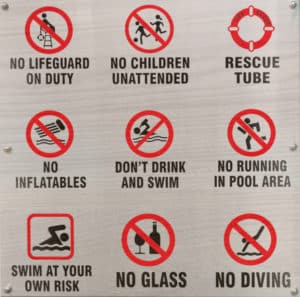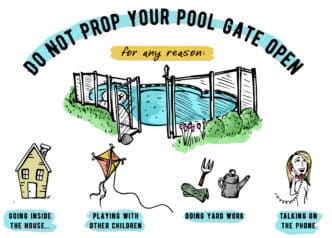

Landlord pool and tenant pool discussions: pools are a luxury many people seek out in a home. But with the thrill of a pool come liabilities and questions about who is responsible for a safety barrier at a rental property?
Whether a long term, vacation, or short-term rental like Airbnb, the major monetary obligations usually fall on the landlord when it comes to pool safety. It is expected that property owners should maintain common areas to keep their property safe under their general duty as a landlord and owner.
The property owner must abide by pool safety legislation and install any required safety barriers (like a self-closing latching gate around the pool) if their city or municipality mandates it. However, if not required by state or local law, cautious parents of young children may still want to have a pool safety fence or cover installed.
The first step of the tenant would be to find out the code from their local building department and get permission from the landlord before erecting a pool safety barrier system. Just as upgrading the door locks or replace flooring in a rental home without permission are a lease violation, so is drilling into the pool decking to add a pool safety barrier system. Even though it may be considered an upgrade or improvement, it’s a significant change and can be grounds for eviction or expensive restoration.
Cost is another factor to consider when installing a pool barrier. If a pool safety system is not required by state law, the landlord would not necessarily be responsible for the cost. It will be at the landlord’s discretion if they decide to cover the expense or a portion of it. Keep in mind, tax benefits may be available from depreciation deductions of pool fencing and other outdoor structures.

It is the tenant’s responsibility to supervise the use of the pool. Although, you may want them to sign a swimming pool waiver as part of the landlord pool agreement to defer some of the liabilities.
If not already addressed in the lease, consider adding a lease addendum. The addendum could make the maintenance of the pool or spa the tenant’s responsibility. Otherwise, an owner may choose to hire a pool company that can maintain the pool and report back if anything needs attention, like a crack in the pool deck. Sample pool liability waivers can be found online but it would be wise to be extra cautious and consult local counsel.
In the event that a tenant doesn’t maintain the pool, or the landlord simply doesn’t want the risk, they can drain it. Landlords are not required to make the pool usable unless it’s outlined in the lease agreement. However, draining a pool often brings more issues and a new set of problems in regard to the pool structure and safety.
It is recommended to share information about pool safety with tenants when they move in and be sure to review their responsibilities as outlined in the rental agreement. Note in some states such as Arizona this is mandatory. Under the Arizona Residential Landlord-Tenant Law, landlords who rent property with access to a swimming pool must provide the tenant with a pool safety notice (A.R.S. § 36-1681(E)).

• Installing a safe pool barrier installed to meet, at the minimum, the maximum standard of local pool barrier code.
• Adding a pool addendum / pool liability waiver to your tenant’s lease.
• Posting pool safety notices on doors leading to the backyard and pool, and/or on a notice board nearby.
• Installing a designated hook, high up by the door leading to the backyard, specifically for the gate key. A water-watcher card with a whistle could also be hung here.
• Posting depth markers, and no diving and no running notices by the pool.
• Providing and installing a rescue pole (shepherds crook) and life ring by the pool area.
• Making sure the pool area is well lit, and trees and shrubbery are kept trimmed back for maximum visibility.
• Placing a “did you lock the pool gate?” sign on the pool gate.
• Providing tenants a binder with further pool safety and drowning prevention information within.

Take steps to protect your tenants, yourself, and your investment. Contact Katchakid to get a free, no-obligation quote on a pool safety barrier for your rental property.
Information in this article current as of February 2020.


April 23, 2016

May 10, 2023